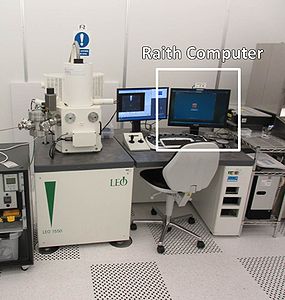Specific Process Knowledge/Lithography/EBeamLithography/RaithElphyManual: Difference between revisions
| Line 3: | Line 3: | ||
= <span style="background:#FF2800">THIS PAGE IS UNDER CONSTRUCTION</span>[[image:Under_construction.png|200px]] | = <span style="background:#FF2800">THIS PAGE IS UNDER CONSTRUCTION</span>[[image:Under_construction.png|200px]] | ||
= Purpose, location and technical specifications = | = Purpose, location and technical specifications = | ||
[[File:RaithPC.jpg|thumb|300x300px|The Raith computer is located right next to the LEO SEM pc]] | |||
The Raith Elphy system is a pattern generator built onto the [[Specific_Process_Knowledge/Characterization/SEM:_Scanning_Electron_Microscopy/Leo|LEO Scanning Electron Microscope ]] (SEM) in cleanroom F-2. All users must therefore acquire license to use the SEM LEO before acquiring license to the Raith Elphy system. | The Raith Elphy system is a pattern generator built onto the [[Specific_Process_Knowledge/Characterization/SEM:_Scanning_Electron_Microscopy/Leo|LEO Scanning Electron Microscope ]] (SEM) in cleanroom F-2. All users must therefore acquire license to use the SEM LEO before acquiring license to the Raith Elphy system. | ||
| Line 13: | Line 15: | ||
*Send the files to yourself on your DTU email. You can then access and download them from the DTU [http://mail.win.dtu.dk webmail page] | *Send the files to yourself on your DTU email. You can then access and download them from the DTU [http://mail.win.dtu.dk webmail page] | ||
*For more advanced functionality, use the [http://remote.dtu.dk Citrix page] with your DTU login. You can then use Citrix's Remote desktop??? or Explorer app??? to operate and transfer files between the local pc and your personal M: drive. | *For more advanced functionality, use the [http://remote.dtu.dk Citrix page] with your DTU login. You can then use Citrix's Remote desktop??? or Explorer app??? to operate and transfer files between the local pc and your personal M: drive. | ||
= Mounting of chips or wafers into chamber = | = Mounting of chips or wafers into chamber = | ||
Revision as of 12:20, 1 March 2016
Feedback to this page: click here
= THIS PAGE IS UNDER CONSTRUCTION
Purpose, location and technical specifications
The Raith Elphy system is a pattern generator built onto the LEO Scanning Electron Microscope (SEM) in cleanroom F-2. All users must therefore acquire license to use the SEM LEO before acquiring license to the Raith Elphy system.
Remember that you need two additional trainings from Danchip staff in order to be able to use this tool for lithography. Please refer to the General Page for further information.
The Raith ELPHY Quantum software (from now on, Elphy) is installed on the Raith pc located right next to the LEO SEM pc. The workstation is more or less independent from the LEO itself. If you try to access Elphy without properly setting up the microscope first, it will usually return a communication error, but it would still be partially functional e.g. to prepare layouts and position lists. When you want to do actual patterning, you will need to operate on both computers at the same time.
The pc has limited access to internet and the network. To import and export files on the Raith pc, two options are available:
- Send the files to yourself on your DTU email. You can then access and download them from the DTU webmail page
- For more advanced functionality, use the Citrix page with your DTU login. You can then use Citrix's Remote desktop??? or Explorer app??? to operate and transfer files between the local pc and your personal M: drive.
Mounting of chips or wafers into chamber
It can be difficult to align the beam properly to a chip coated with e-beam resist. It is thus recommended to remove the resist on a corner of the chip, preferably a place on the chip where you easily can adjust the beam, i.e. on metallised structures on the chip.
- Ventilate the SEM chamber
- Mount your chips(s) on the Raith Specimen holder
- Mount the holder on the SEM stage, evacuate the SEM chamber
| Chip holder to Raith Elphy E-beam writer system; the holder has three clamps to hold up to 3 chips and a Faraday's cup to measure beam current. The holder is equipped with a dovetail that fits to the stage of the SEM. |
Software login
- Start the Raith ELPHY Quantum software from the desktop of the Raith computer (screen to the right).
- Login with the following password:
User ID Password
- Start RemCon32 from the desktop on the SEM computer (screen to the left), choose 'COM 6', right-click and press 'start'
Preparation of a pattern file, GDS
You can either draw your pattern in L-edit, CleWin or AutoCAD and import the GDS file to the Raith computer. In that case it is important to flatten your design; the Raith software does not like instances.
You can also draw your pattern in the Raith software by clicking the 'Design' icon:
Pepare beam for writing
Before you start preparing your beam, a few recommendations:
- It is recommended to move the stage (by joystick) instead of deflecting the beam (ctrl + tab); this to ensure that you work with an undeflected beam while preparing the beam for patterning and while patterning your GDS.
- It is recommended not to rotate the scan by the 'scan' knob; this...
- Measure beam current:
- Click 'Stage Control/Positions/Faraday's cup', make sure the stage moves to the center of the Faraday's cup, increase the magnification to 100.000x or more
- Toggle beam blanker to switch on beam
- Make sure you operate at a working distance of 5 mm
- Click 'XX' to measure beam current
- Move the stage to a corner of your chip. With the joystick (or from the 'stage' tab in the SEM software), rotate the stage to align the chip
- Adjust beam quality, i.e. focus, astigmatism, wobbling at a magnification of 100.000 x or more
- Move to a new spot on the chip and switch the SEM to 'spot mode'; burn a spot in the resist (approximately 20s). Correct astigmatism and aperture alignment on that spot.
- Burn a spot with a larger magnification and adjust beam quality again.
- Burn a spot at a lower magnification to see that the spot is circular at this magnification
Stage adjustment
XY is stage coordinate system, UV is sample coordinate system:
- Origin correction:
- Click 'Adjustment/Adjust UV/Origin correction'
- Move the stage to the lower left corner of the chip
- Enter (U,V)=(0,0) and click 'adjust'
- Angle correction:
- Click 'Adjustment/Adjust UV/Angle Correction', make sure the system is in 'Global' mode
- Turn on the crosshair (SmartSEM/View)
- Set magnification to approximately 100x
- turn off beam and click 'Label1/flash'-icon to move stage to the origin.
- Click 'label1/pippette'-icon
- Move stage to the lower right corner of the chip
- click 'label2/pipette'-icon.
- Click adjust: the button hereafter turns green
Exposing
- Click 'Design/open' to open a GDS file. Click 'View/Hierarchy/Max' from the menu bar to see full structure
- Set the writing field:
- Click 'Raith/Writefield Manager', right-click on the writing field you wish to use and click 'SET'
- Click 'File/Positionlist' and drag your GDS-file to the position list.
- Right-click on the pattern name in the positionlist and click 'properties':
- Enter center position of pattern in (U,V) coordinates
- Click 'Layer' and select layers of the pattern to expose
- Click 'Patterning Parameters', click the calculator icon.
- Select Area/Line/Dot and enter area dose/line dose/dot dose.
- Enter step size (beam shot pitch) and line spacing for area/line/dot
- Click calculator icon again, click 'OK' when 'OK' is highlighted
- Go to the positionlist, right-click on the pattern to expose and select 'Properties/patterning parameter/Times'
- Activate the positionlist.
- Click 'Scan/selection' from the menu bar. Exposure will start.
